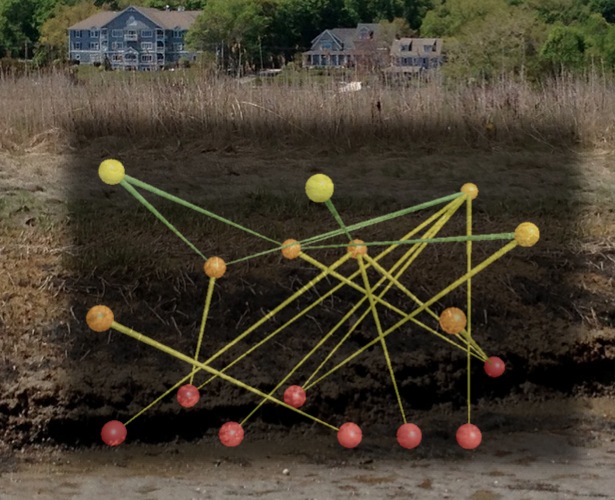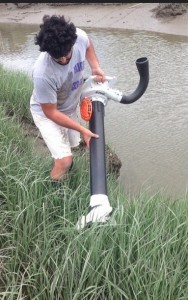
Salt marshes are a fascinating ecosystem where land and sea meet. Terrestrial ecosystems full of grasses, spiders, and insects overlap with marine ecosystems of crabs, snails, fish, and algae. They’re a unique ecosystem, and one that serves a wide variety of critical ecosystem services.
Because of these unique properties, they provide an ideal testing group for both ecological theory and applied ecology in a way few others do. In the salt marshes of New England, I’m interested in exploring several themes:
Just what do salt marsh food webs look like? With their dual marine and terrestrial compartments, salt marshes have a fascinating structure. I’m interested in quantifying this network topology, and then examining how those topological properties might contribute to the stability and resilience of salt marsh food webs. This presents a lot of fun challenges – from digging through the literature to bring together the vast amount of marsh natural history out there to performing detailed feeding trials and field collections to assess interaction strengths. There’s a lot of basic natural history to be done in order to see the big picture.
 How does environmental change shape salt marsh food webs? As this web comes together, we know from other systems that not every marsh will have a fully represented web. What marshes have more of a terrestrial than marine web? What about vice-versa? Are there certain environmental or urban influences that shape marsh food web structure? This is only the tip of the iceberg for linking natural and human influences with salt marsh food web structure.
How does environmental change shape salt marsh food webs? As this web comes together, we know from other systems that not every marsh will have a fully represented web. What marshes have more of a terrestrial than marine web? What about vice-versa? Are there certain environmental or urban influences that shape marsh food web structure? This is only the tip of the iceberg for linking natural and human influences with salt marsh food web structure.
How does salt marsh food web structure translate to ecosystem functions and services? Because of their dual marine-terrestrial nature, salt marshes provide an amazing test-bed to ask how does the structure of food webs modify the consequences of changes in diversity for multiple ecosystem functions. We’re addressing this questions using two approaches funded by MIT SeaGrant. First, we’re surveying marshes all over New England. In each marsh, we’re quantifying not only the food web, but multiple ecosystem functions. This will allow us to link food web structure and full ecosystem multifunctionality. Additionaly, we’re working on experiments that attempt to manipulate diversity while holding food web structure constant, and vice-versa, by altering the fraction of marine to terrestrial consumers. We’ll then be able to tease apart the causal links between species diversity, salt marsh food web structure, and ecosystem multifunctionality. With these new insights, we’ll be armed to understand changes to salt marshes in a whole new way.
Relevant References
Roy, M. S., J. E. K. Byrnes, and G. Mavrommati. 2023. Mitigation policies buffer multiple climate stressors in a socio-ecological salt marsh habitat. Sustainability Science. https://dx.doi.org/10.1007/s11625-023-01414-0
Hensel, M.J., Silliman, B.R., Hensel, E. and Byrnes, J.E.K. 2021. Feral hogs control brackish marsh plant communities over time. Ecology. Accepted Author Manuscript e03572. https://doi.org/10.1002/ecy.3572
Hensel, M. J. S., B. R. Silliman, J. van de Koppel, E. Hensel, S. J. Sharp, S. M. Crotty, and J. E. K. Byrnes. 2021. A large invasive consumer reduces coastal ecosystem resilience by disabling positive species interactions. Nature Communications 12:6290. https://doi.org/10.1038/s41467-021-26504-4
